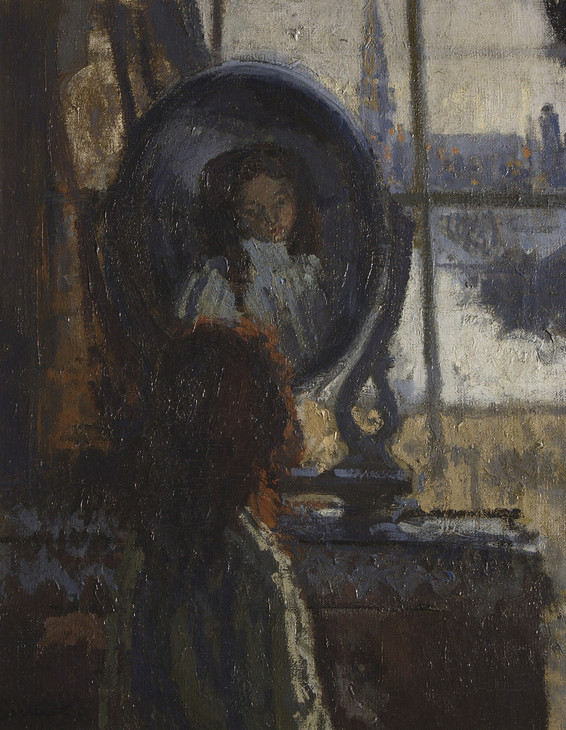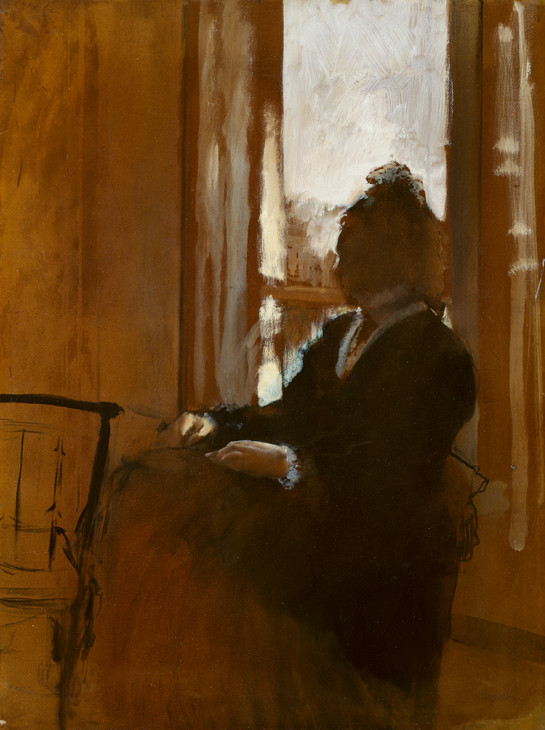Walter Richard Sickert Girl at a Window, Little Rachel 1907
Walter Richard Sickert,
Girl at a Window, Little Rachel
1907
This painting is dominated by the French window of Sickert’s north-facing front room at 6 Mornington Crescent. Light falls softly on the dim figure of the red-haired girl, seen looking across Mornington Crescent Gardens. Rachel, the daughter of his frame maker, features in five known oil paintings by Sickert.
Walter Richard Sickert 1860–1942
Girl at a Window, Little Rachel
1907
Oil paint on canvas
508 x 406 mm
Inscribed by the artist ‘Sickert’ bottom right
Accepted by HM Government in lieu of inheritance tax and allocated to the Tate Gallery 1991
T06447
1907
Oil paint on canvas
508 x 406 mm
Inscribed by the artist ‘Sickert’ bottom right
Accepted by HM Government in lieu of inheritance tax and allocated to the Tate Gallery 1991
T06447
Ownership history
Probably purchased from the artist in 1907 by Hugh Hammersley (1858–1930); ... ; Dr Robert Emmons (1894–1963) by 1947; bought Agnew’s in 1947 by Roland, Browse and Delbanco; T.W. Strachan by 1953; Roland, Browse and Delbanco, from whom bought in 1960 by William Evan Wallace (1927–1977); his widow, Hon. Mrs Elizabeth Ann Wallace (1933–1990), from whose estate accepted by HM Government in lieu of inheritance tax and allocated to Tate Gallery 1991.
Exhibition history
1947
Exhibition of Paintings and Drawings by W.R. Sickert from the Collection of Robert Emmons, Agnew’s, London, May–June 1947 (56, as ‘Girl at a Window’).
1953
Paintings and Drawings by Walter Sickert, Royal Scottish Academy, Edinburgh, January 1953 (13).
1960
Sickert 1860–1942, Roland, Browse and Delbanco, London, March–April 1960 (24, as ‘Girl at a Window – Rachel’).
1962
Sickert, Royal Pavilion Art Gallery, Brighton, June 1962 (31).
1973
Sickert, Fine Art Society, London, May–June 1973, Fine Art Society, Edinburgh, June 1973 (60).
1979–80
Post-Impressionism: Cross-Currents in European Painting, Royal Academy, London, November 1979–March 1980 (340, reproduced).
1988
The Painters of Camden Town 1905–1920, Christie’s, London, January 1988 (40, reproduced).
1992–3
Sickert: Paintings, Royal Academy, London, November 1992–February 1993, Van Gogh Museum, Amsterdam, February–May 1993 (64, reproduced).
2005–6
Degas, Sickert and Toulouse-Lautrec: London and Paris 1870–1910, Tate Britain, London, October 2005–January 2006 (104, reproduced).
2008
Modern Painters: The Camden Town Group, Tate Britain, London, February–May 2008 (36, reproduced).
References
1973
Wendy Baron, Sickert, London 1973, pp.103–4, 114, 347 no.263, reproduced pl.182.
1979
Wendy Baron, The Camden Town Group, London 1979, pp.19, 142, 152, 154, 162, reproduced pl.34.
1990
British and Irish Traditionalist and Modernist Paintings and Watercolours, Christie’s, London 8 November 1990, lot 74, reproduced.
1992
Tate Gallery Report 1990–2, London 1992, p.33, reproduced.
2000
Wendy Baron, Perfect Moderns: A History of the Camden Town Group, Aldershot and Vermont 2000, pp.32, 92–3, 136, 138, 139, 205, reproduced pl.3 and on back cover.
2001
David Peters Corbett, Walter Sickert, London 2001, pp.32, 34, reproduced fig.26 as Girl at a Window (Little Rachel).
2006
Wendy Baron, Sickert: Paintings and Drawings, New Haven and London 2006, no.337, reproduced.
Technique and condition
Girl at a Window, Little Rachel was painted on a coarse-weave linen canvas that Walter Sickert bought from the artists’ colourmen John B. Smith (see also Tate T00164). The cloth has a plain weave with uneven threads; it is sized and primed with an even coat of white primer that conforms to the canvas weave texture. There are splashes of a white water-based paint or primer on the back of the canvas and on the stretcher, but these do not appear to be contemporary with the preparation or the painting. The priming has no obvious overall toning but it is covered by much later paint and is difficult to see.
The painting is roughly brushed with rather thin paint in dull blues, greys and browns to delineate form, which tends to emphasise the visible pattern of the canvas weave texture. A more medium-rich, thicker paint has been applied over this thinner underpainting using a flat-headed brush, which exuded wet paint at the sides of each stroke and formed brushmarked impasto. The underlying layers are left visible in places where paint has been unevenly applied only partially covering underlying paint, as in the sky, for example.
Not all the brushmarks are aligned with the final image. The figure in particular appears to have been heavily reworked and there are modifications to the position of the window frame and railings. The painting has been varnished with a soft resin to provide an even gloss and saturation but the final image remains a painterly impression of the subject.
Stephen Hackney
December 2004
How to cite
Stephen Hackney, 'Technique and Condition', December 2004, in Robert Upstone, ‘Girl at a Window, Little Rachel 1907 by Walter Richard Sickert’, catalogue entry, May 2009, in Helena Bonett, Ysanne Holt, Jennifer Mundy (eds.), The Camden Town Group in Context, Tate Research Publication, May 2012, https://wwwEntry
Sickert painted Girl at a Window, Little Rachel during the summer of 1907, putting off his planned trip to Dieppe and Paris as he became interested in the sequence of paintings he was making. It was an important period for the artist, when he self-consciously tried to consolidate and extend his artistic development. He wrote to his friend, the artist Nan Hudson:
I am clear-sighted enough to realize that the backward position I am in, for my age, and my talent, is partly my own fault. I have done too many slight sketches, & too few considered, elaborate works. Too much study for sake of study, & too few résumés of the results of study ... I shall try this summer to do a few really complete canvases in Dieppe and Paris.1
But Sickert stayed on in his Mornington Crescent rooms, from where he later wrote to Hudson:
I am very much afraid you must be having a hell of a time by the Thames. Even I in my ark in the crescent am chilly.
This is to tell you I have got entangled in a batch of a dozen or so interiors on the first floor here. A typical lodgings first-floor. If you are in London any day & could come I should like to show you a set of studies of illumination half done. I am very much interested & shall stay till they are done. A little Jewish girl of 13 or so with red hair & a nude alternate days.2
This is to tell you I have got entangled in a batch of a dozen or so interiors on the first floor here. A typical lodgings first-floor. If you are in London any day & could come I should like to show you a set of studies of illumination half done. I am very much interested & shall stay till they are done. A little Jewish girl of 13 or so with red hair & a nude alternate days.2

Walter Richard Sickert 1860–1942
Girl at a Looking-Glass, Little Rachel 1907
Oil paint on canvas
511 x 410 mm
Fitzwilliam Museum, Cambridge
© Estate of Walter R. Sickert / DACS
Photo © Fitzwilliam Museum, University of Cambridge
Fig.1
Walter Richard Sickert
Girl at a Looking-Glass, Little Rachel 1907
Fitzwilliam Museum, Cambridge
© Estate of Walter R. Sickert / DACS
Photo © Fitzwilliam Museum, University of Cambridge
According to Sickert’s title for one of these oils and one of the drawings, the sitter was the daughter of his frame maker. Using information supplied by Agnew’s, the art historian Wendy Baron records that Rachel’s surname was Siderman, and that she died in 1963 aged 70. However, on her marriage certificate her father’s profession was listed as grocer.8 Richard Kingzett of Agnew’s recalled his gallery’s Sickert exhibition of 1960 in which the canvas of Little Rachel, now in Plymouth City Museum and Art Gallery, was displayed:
What I think happened was that Miss Siderman came into that exhibition in 1960, and identified herself as the sitter. Geoffrey Agnew wrote the catalogue for our 1947 exhibition of Dr. Emmons’s pictures, and knew Dr. Emmons well. It is possible that he or his cousin Hugh Agnew, who was also a close friend of Emmons, was told about Little Rachel’s identity in that year by Dr. Emmons, but I cannot find anything about this in the archives here.9
London Trade and General Post Office directories for the last decade of the nineteenth century and the first decade of the twentieth century do not list any frame makers (of which, interestingly, there are a very large number) named Siderman, although he could perhaps have worked for a larger company not bearing his name. Nor does the 1911 census record anyone named Rachel Siderman, or girls with that surname of a suitable age.

Edgar Degas 1834–1917
Woman at a Window 1871–2
Oil paint on canvas
613 x 459 mm
The Samuel Courtauld Trust, The Courtauld Gallery, London
Photo © The Samuel Courtauld Trust, The Courtauld Gallery, London
Fig.2
Edgar Degas
Woman at a Window 1871–2
The Samuel Courtauld Trust, The Courtauld Gallery, London
Photo © The Samuel Courtauld Trust, The Courtauld Gallery, London
If he [the artist] lives in a northern climate and has no hankering for physical martyrdom, he, with the rest of his countrymen, will work indoors. The house, where man is born, and married, and dies, becomes his theatre, and the sun shines as well, if sometimes more indirectly, on the indoor as on the outdoor man. It may be that the windows, framing and limiting the light, act on the indoor landscape as the frame of the sonnet-form acts on a stream of poetic light, not always with detriment. We all know that picture of Moritz von Schwind, of the little German girl in plaits who throws open the casement of her bedroom to greet the sounds and scents of morning. The everlasting matutinal is enshrined in it once for all and for ever ... Or take the afternoon ... The afternoon light flows in through the open folding doors, from the small back-room in the classic uniform English first floor, into the bigger front room.10
In Girl at a Window, Little Rachel, Sickert shows his sitter standing by the French windows of his north-facing, first-floor front room at 6 Mornington Crescent, London NW1, which he kept in 1907, just a few doors away from his friend Spencer Gore who lived at number 31. The room was rented, as Sickert wrote in a letter of 1907 to Nan Hudson addressed from Mornington Crescent, ‘I rather hope that when I come back in the autumn I may take the floor above my lodgings here as a room-studio and do the interiors I love’.11 The 1907 Kelly’s Camden and Kentish Town Directory lists the householder as ‘Mrs George Jones Jr’, who was presumably Sickert’s landlady. Mornington Crescent was only one of Sickert’s addresses, and at this time he also had another studio in Fitzroy Street. Following his return to London in 1905 Sickert had continued the practice he followed in Dieppe of keeping several studios at once, which probably sometimes doubled as living accommodation. The art critic Clive Bell recalled Sickert at a somewhat later period ‘showing us his “studios” – “my drawing studio” “my etching studio” etc. The operation involved chartering a cab and visiting a series of small rooms in different parts of London.’12
Through the window Sickert shows the view across Mornington Crescent Gardens, on which the Carreras cigarette factory was built in 1928. The steeple visible on the horizon is that of St Matthew’s Church in Oakley Square. Designed in Gothic Revival style by John Johnson, it was built in 1852–6 and demolished in 1977. Oakley Square was built at the same time as the church, part of the Bedford New Town development, which was demolished in 1980 to make way for blocks of flats.
It is likely that the first owner of Girl at a Window, Little Rachel was Sickert’s patron Hugh Hammersley. In a letter to Hudson, Sickert wrote that Hammersley, who had already bought
my portrait with the casts in the last New English,13 came on Tuesday and bought 3 new ones, two nudes and a child at a window ... He paid £60 for the three instead of £36 which the Bernheims would have given, so it is a stroke of luck. Also that makes rather an important collection of my work in a London House.14
Hammersley made his money in the City, and spent it at the New English Art Club. He and his wife Mollie became great friends of Sickert, and he was a regular part of the circle of artists and writers who gathered at their house in Hampstead.15 Sickert’s friend and pupil, Dr Robert Emmons (1894–1963), was the first definite owner of Girl at a Window, Little Rachel. An American, he practised medicine in London during the 1920s, but painting came to be his dominant interest, and in October 1927 he enrolled as a student at Sickert’s art school at 1 Highbury Place, Islington. He exhibited his work at the Royal Academy in 1928 and 1932.16 Emmons was the author of The Life and Opinions of Walter Richard Sickert, the first biography of the artist, published by Faber in 1941, the year before Sickert died. An important collector of Sickert’s work and of other artists of the period, his collection was put on show in 1947 at Agnew’s, including Girl at a Window, Little Rachel.
Robert Upstone
May 2009
Notes
http://www.fitzmuseum.cam.ac.uk/opacdirect/3873.html . Wendy Baron, Sickert: Paintings and Drawings, New Haven and London 2006, no.338.
Walter Sickert, ‘A Stone Ginger’, New Age, 19 March 1914, p.631, in Anna Gruetzner Robins (ed.), Walter Sickert: The Complete Writings on Art, Oxford 2000, p.344.
Quoted in W.R. Sickert: Drawings and Paintings 1890–1942, exhibition catalogue, Tate Liverpool 1989, p.16.
Sickert is referring to his reflected self-portrait The Painter in his Studio 1907 (Hamilton Art Gallery, Ontario); reproduced in Baron 2006, no.331 and Sickert: Paintings, exhibition catalogue, Royal Academy, London 1992 (63).
Related biographies
Related essays
Related film
-
Conservator Stephen Hackney on Walter Sickert's Girl at a Window, Little Rachel 1907© 2011 Tate
How to cite
Robert Upstone, ‘Girl at a Window, Little Rachel 1907 by Walter Richard Sickert’, catalogue entry, May 2009, in Helena Bonett, Ysanne Holt, Jennifer Mundy (eds.), The Camden Town Group in Context, Tate Research Publication, May 2012, https://www


